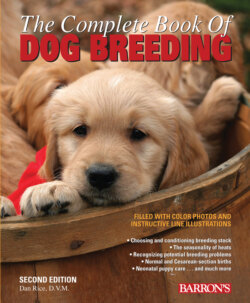Читать книгу The Complete Book of Dog Breeding - Dan Rice - Страница 35
На сайте Литреса книга снята с продажи.
Temperament
ОглавлениеNo matter which breed you choose, regardless of how similar they appear, all dogs of a breed are not identical. Each individual has its own genetic makeup. Its temperament as an adult reflects the dispositions of both parents as well as its bonding and treatment as a puppy. If you already own the dog that you plan to breed, it may be too late to look at its parents’ temperaments, but you can still objectively analyze your dog’s attitude. Your decision to breed a dog with a grouchy, snappy disposition might have horrible consequences.
Example: I knew a large male dog of a breed that is known for its aggressiveness as guards. I examined the animal in the clinic dozens of times without incident. I trimmed and sanded his toenails, treated infected ears, vaccinated him, and otherwise tested our relationship regularly. He was a pussycat—not an aggressive bone in his body.
In his exhibition career he was shown frequently in both conformation classes and obedience trials, where his handlers and judges saw no evidence of a disposition fault. He easily acquired the points necessary to receive both his AKC conformation championship and CD obedience degree. He belonged to a family with three small children, all of whom wrestled and played with him daily.
TIP
As a conscientious breeder, select a puppy whose parents are known to have an agreeable temperament.
He displayed one personality problem, and that was manifested only in his own home. When he was six or seven months old, his owners discovered he had a quick temper and was sensitive to being touched by anyone other than his family. He did not aggressively attack strangers, and he tolerated household visitors very well as long as they kept a respectable distance. When touched by them, however, his immediate response was to snap. Because he had never actually attacked or bitten anyone, his owners accepted what they considered to be a minor character quirk.
One day, when the dog was about four years old and weighed over 85 pounds, a tragedy occurred. A six-year-old girl, who lived next door and regularly visited the family, put her arm around the dog’s neck as the children sat on the floor watching TV. He responded by ripping her face and ear, leaving her scarred for life.
The consequences of that incident were far reaching. They included several years of terribly painful, modestly successful but very expensive plastic surgery, a divorce, the sale of a home, and long, spiteful litigation between former friends and neighbors.
Between two and four years of age, after winning his championship in the show ring, the dog sired several litters of beautifully marked, excellent conformation puppies, many of whom displayed the same untrustworthy characteristic as adults. Consequently, at least three or four of the puppies were euthanized over the next few years.
The moral of the story is simple. Personality traits are important and, to some degree, hereditary. Dams and sires must be evaluated for more than their conformity to breed standards. When choosing a pup as a breeding animal, handle both its sire and dam. If possible, meet and handle dogs produced previously from both the sire and dam.
A dog breeder should always try to improve the breed. To include animals with personality faults in your breeding program is just as dangerous as including animals known to have hip dysplasia or hereditary eye problems.
